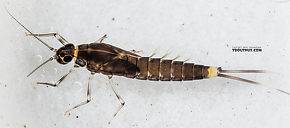Blog & Latest Updates
Fly Fishing Articles
Insects by Common Name


Mayfly Species Diphetor hageni (Little Blue-Winged Olive)
Taxonomic Navigation -?-
Kingdom
Animalia (Animals)
» Phylum
Arthropoda (Arthropods)
» Class
Insecta (Insects)
» Order
Ephemeroptera (Mayflies)
» Family
Baetidae (Blue-Winged Olives)
» Genus
Diphetor (Blue-Winged Olives)
» Species hageni (Little Blue-Winged Olive)
Common Names
Dorsal (Dorsal: Top.) abdominal markings on the nymphs used to differentiate the species in these older works have since proved unreliable. The easiest way to tell them apart from B. tricaudatus is their lack of gills on the first abdominal segment. Telling adults apart is equally tough. Duns of D. hageni are typically a little smaller, but their bodies can also be olive, brownish olive and even two toned with thoraxes a shade of brown or tan with paler olivacious abdomens.
Diphetor hageni has two former names used in angling literature, Baetis parvus in the West and Baetis divinctus in the East.
Where & When
Regions: East, Midwest, West
Time Of Year (?): April and May, then another brood in September and October; sometimes another intermediate brood
Preferred Waters: Fertile streams
Hatching Behavior
The nymphs and duns are both important during this hatch.
Spinner Behavior
Fred Arbona in Mayflies, the Angler, and the Trout describes peculiar spinner behavior in this species:
Spinners gather in the mornings or evenings, and their tight swarms can be observed over the banks of the stream. After mating, the spinners suddenly vanish and reappear spent (Spent: The wing position of many aquatic insects when they fall on the water after mating. The wings of both sides lay flat on the water. The word may be used to describe insects with their wings in that position, as well as the position itself.) on the water.
Nymph Biology
These nymphs are very versatile: cold or warm water, slow or fast water, spring creeks and freestone streams.
Pictures of 1 Mayfly Specimen in the Species Diphetor hageni:
Diphetor hageni (Little Blue-Winged Olive) Mayfly Nymph View 6 Pictures
View 6 Pictures
 View 6 Pictures
View 6 PicturesCollected July 25, 2019 from Mystery Creek #249 in Washington
Added to Troutnut.com by Troutnut on July 26, 2019
Added to Troutnut.com by Troutnut on July 26, 2019
Your Thoughts On Diphetor hageni:
Top 10 Fly Hatches
Top Gift Shop Designs
Eat mayflies.
Top Insect Specimens
Miscellaneous Sites
Troutnut.com is copyright © 2004-2024 Jason
Neuswanger (email Jason). See my FAQ for information about use of my images.
 privacy policy
privacy policy
